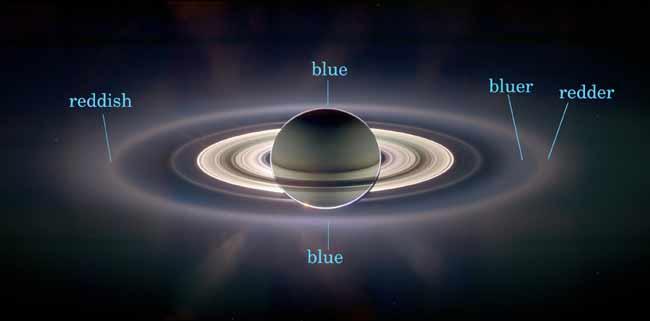Saturn’s Shadow Sheds Light on Rings

NASAscientists think they might have a lead on where to find Saturn's missing moons: near ringsrecently discovered by the Cassini spacecraft.
Inmid-September, the sun was poised behind Saturn, providing Cassiniscientists with an unprecedented imaging opportunity.
Under thecover of the planet's shadow, the entire ring system became visible, andnever-before-seen microscopic particles began to appear.
Thespacecraft discovered a single, faint new ring at the orbits of two moonlets, Janus and Epimetheus. A second,narrow ring that overlies the orbit of the tiny moon Pallenewas found a week later. A third and fourth ring are visible in the Cassini Division, the big gap in Saturn's main ring system.
Scientistssuspect a moon might be lurking near one of the new rings.
"Just likethe old maxim that says where there's smoke, there's fire, at Saturn, wherethere's a new ring, there's bound to be a moon," said Jeff Cuzzi,a Cassini scientist at NASA's Ames Research Center.
Saturn'ssmallest moons have weak gravity and cannot retain any loose material on theirsurfaces. When these moons are struck by rapidly moving interplanetarymeteoroids, this loose material is blasted off their surfaces and into Saturnorbit, creating diffuse rings along the moon's orbital path.
Get the Space.com Newsletter
Breaking space news, the latest updates on rocket launches, skywatching events and more!
Collisionsamong several moonlets, or boulder-sized rubble, might also lead to debristrails. For instance, Saturn's G ring doesn't seem to have any single moonlarge enough to see ─ it might have formed from a recent breakup of amoon.
"We are hoton the trail of these possible elusive moonlets," said Joe Burn, Cassini imaging scientist at Cornell University."Finding the moons and learning about their interactions with the rings willhelp us understand how the moons formed and perhaps how the Saturn systemformed."
The Cassini spacecraft was also able to take advantage of theunusual viewing alignment to note distinct color differences in the rings.These differences could indicate variations in compositions and inmicroscopic particles in the rings. They could also imply the particles arebeing sorted by size.
"The mainrings show a neutral color, while the C ring is reddish, and the D and E ringsare quite blue," said Phil Nicholson, another Cassiniscientist at Cornell. "We don't quite understand if these variations are due todifferences in particle size or composition, but it's nice to be surprisedevery once in awhile."
- Saturn's Rings Created by Collision
- Cassini Data Aiding Theories on Origin of Saturn's Rings
- Saturn Surprise: One Ring is Actually a Spiral
- New Ring and Possible Moons Found at Saturn
Join our Space Forums to keep talking space on the latest missions, night sky and more! And if you have a news tip, correction or comment, let us know at: community@space.com.

Space.com is the premier source of space exploration, innovation and astronomy news, chronicling (and celebrating) humanity's ongoing expansion across the final frontier. Originally founded in 1999, Space.com is, and always has been, the passion of writers and editors who are space fans and also trained journalists. Our current news team consists of Editor-in-Chief Tariq Malik; Editor Hanneke Weitering, Senior Space Writer Mike Wall; Senior Writer Meghan Bartels; Senior Writer Chelsea Gohd, Senior Writer Tereza Pultarova and Staff Writer Alexander Cox, focusing on e-commerce. Senior Producer Steve Spaleta oversees our space videos, with Diana Whitcroft as our Social Media Editor.









